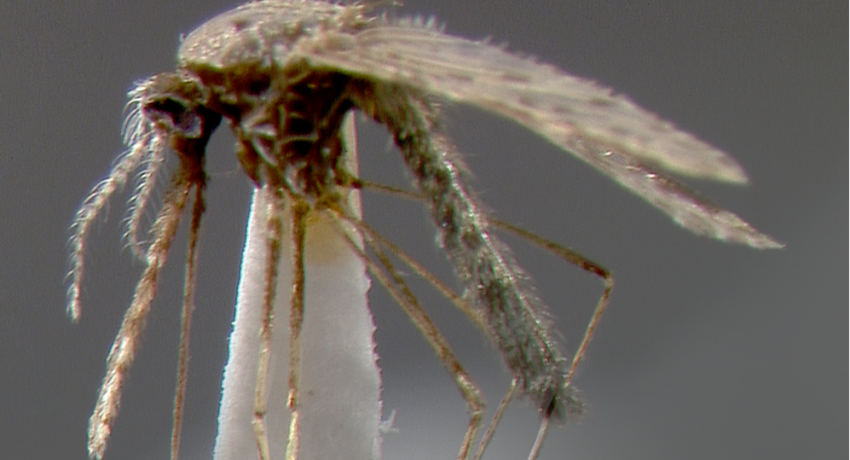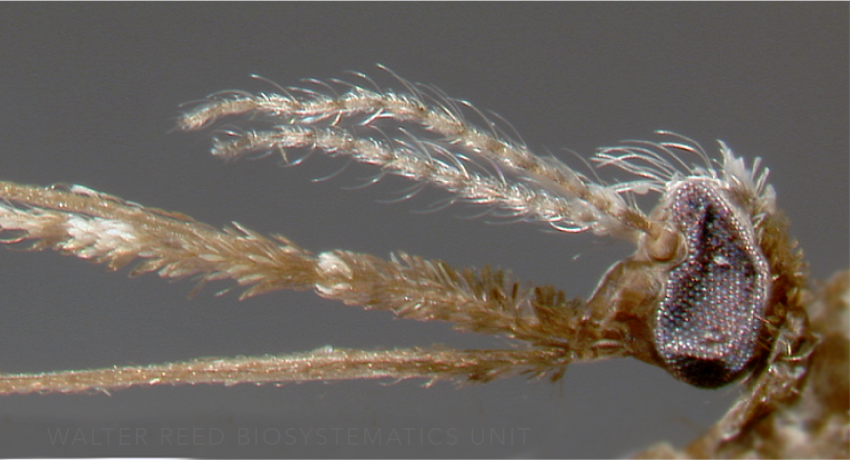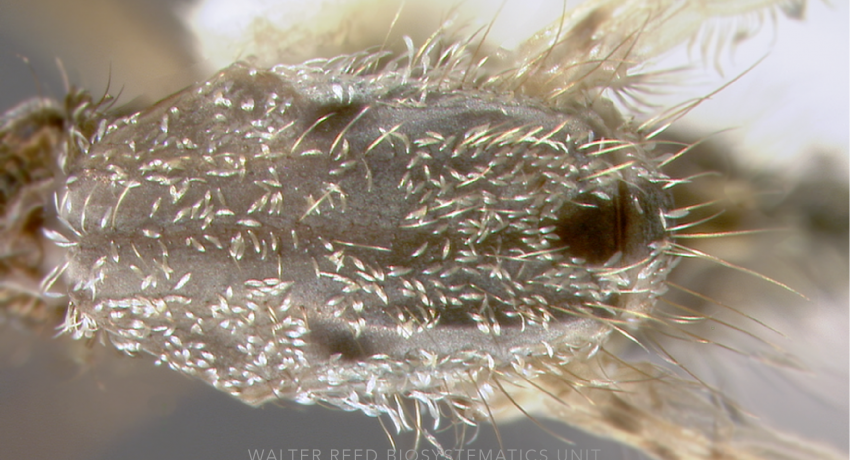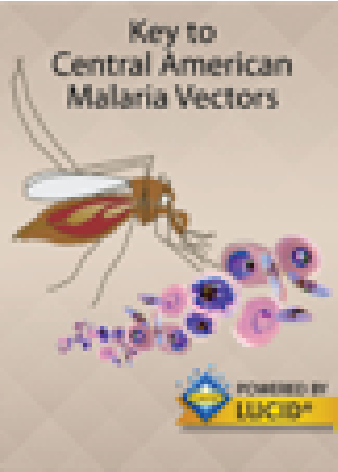NEOTROPICAL REGION
Etymology: from salt water (L)
Anopheles aquasalis mosquitoes have a golden glow, as all the wing scales are yellowish. It belongs to the Oswaldoi Subgroup, along with An. anomalophyllus Komp, An. evansae (Brèthes), An. galvaoi Causey, and An. ininii Senevet & Abonnenc. Anopheles aquasalis has five recognized synonyms—emilianus Komp, guarujaensis Ramos, delta Anduze, guarauno Anduze, and deltaorinoquensis Cova García, Pulido & Amarista.
Type locality: Canal Zone, Panama
Type depository: Location Unknown (LU)
DIAGNOSTIC CHARACTERS (Click photos to view; mouse over and click large photo to zoom in.)
ADULT (illustrated): Head: MPlp4 with at least some white or cream-colored scales on mediolateral surface. Thorax: Postpronotal setae and scales absent; pale scales on C-I–III yellowish, not white. Legs: Ta-III2 with basal dark band 0.3–0.6 x length of segment; Ta-III3,4 entirely white; Ta-III5 with a basal dark band. Wing: Pale scales on wing yellowish, not white; humeral pale spot large, >1.3 x length of prehumeral dark spot; accessory sector pale spot about 0.4 from wing base, conspicuously closer to sector pale than to subcostal pale spot. Abdomen: II-Te with dark posterolateral scale-tufts.
LARVA (not illustrated): Head: Seta 1-A short, <2.0 x width of antenna; setae 2,3-C branched, not dendritic; seta 3-C, and usually 2-C, with apical 0.5 plumose, with moderately long to long branches. Thorax: Seta 1-P palmate, leaflets smooth-sided. Terminal segments: Seta 1-X longer than saddle; seta 1-X at or near ventral margin of saddle.
TAXONOMIC KEYS
Deane, L.M. et al. 1946
Causey et al. 1946
Deane, M.P. et al. 1946
Faran 1980
Becker et al. 2010
Sallum, et al. 2020
![]()
Anopheles – Central America – Adult
![]()
Anopheles – Central America – Larva
![]()
WRBU - Genera - Global - Adult
![]()
WRBU - Genera - Global - Larva
Exemplar DNA sequences
An. aquasalis COI: AF548888–902, KT766410–14; whole genome: GCA_002846955
BIONOMICS
Immatures
The primary immature habitats of An. aquasalis include coastal brackish-water ground pools and mangrove swamps. However, the species has also been collected from freshwater habitats several kilometers inland, and in the laboratory, An. aquasalis females will oviposit in fresh water. Following forced mating of the F1 generation of An. aquasalis collected in Belem, Brazil, the species began to mate freely in cages and the species has now been successfully colonized. This colony rears successfully in well water (0.04% salinity), whereas another An. aquasalis colony established in Rio de Janeiro is maintained at 10% salt concentrations. This plasticity strongly indicates the presence of hidden diversity in this taxa.
Adults
Anopheles aquasalis are highly anthropophilic and readily enter houses to feed and rest. It is regarded as the primary vector of malaria in coastal areas of Venezuela, and the Caribbean islands of Trinidad and Tobago and the Lesser Antilles.
DISTRIBUTION NOTES
Antigua & Barbuda, Argentina, Brazil, Colombia, Costa Rica, Dominica, Dominican Republic, Ecuador, French Guiana, Grenada, Guadeloupe, Guyana, Martinique, Mexico, Montserrat, Nicaragua, Panama, Paraguay, Saint Kitts & Nevis, Saint Lucia, St. Vincent & the Grenadines, Suriname, Trinidad & Tobago, Uruguay, Venezuela, Virgin Islands.
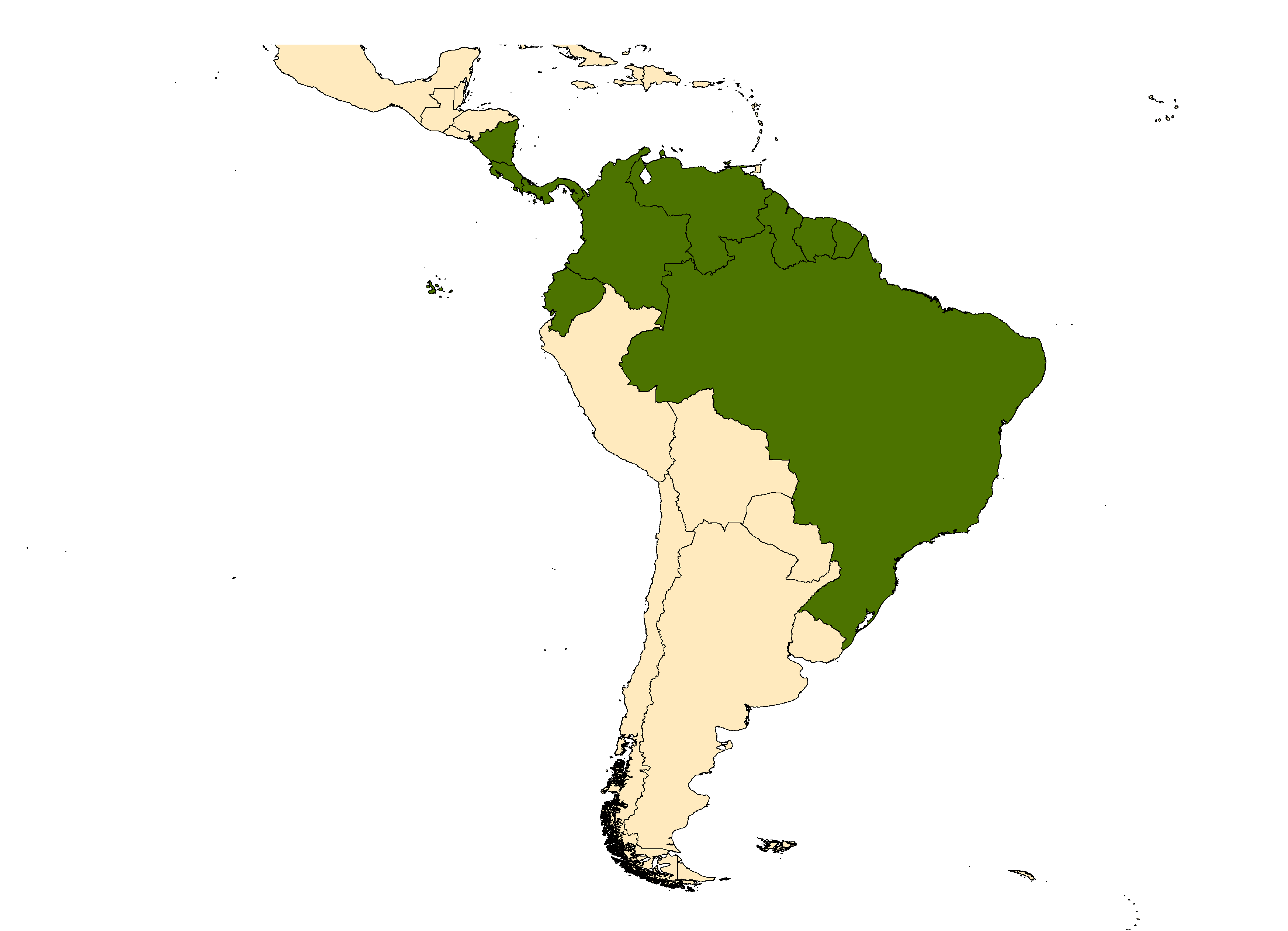
WRBU VECTOR HAZARD REPORTS
VHR: Mosquitoes of the Caribbean
View other WRBU Vector Hazard Reports
Available GIS Models
An_aquasalis_Nyari_1 South & Central America
IMPORTANT REFERENCES (full citations below)
Curry 1932 (M*, L; tarsimaculatus var.)
Gabaldón et al. 1940: 10 (P*, L*)
Rozeboom & Gabaldón 1941: 91 (M*; taxonomy; to species)
Rozeboom 1942a: 242 (E*; taxonomy)
Ross & Roberts 1943a: 33 (M*, F*, L*)
Floch & Abonnenc 1945a (M*, F*, L*; distribution; Guadeloupe)
Cova-García 1946, Fig. 1 (E*), 35 (L*), 87 (F*), 122 (M*)
Causey et al. 1946 (M*, key; NE Brazil & Amazonas)
Deane, M.P. et al. 1946 (L*, key, bionomics; NE Brazil & Amazonas)
Coher 1949 (1948): 87 (F)
Downs 1950 (morphology)
Kitzmiller & Chow 1971 (chromosomes*)
Faran 1980: 75 (M*, F*, P*, L*; keys, taxonomy, bionomics, distribution)
Perez & Conn 1992 (chromosomes)
Linley et al. 1993b (E*)
Flores-Mendoza & Lourenço-de-Oliveira 1996 (bionomics)
Maldonado et al. 1997 (E*; taxonomy)
Grillet et al. 1998 (bionomics)
Khouri & Lopes 2000 (F genitalia)
Fairley et al. 2002 (population genetics)
Fairley et al. 2005 (molecular taxonomy)
Sinka et al. 2010: 72 (bionomics review, distribution, niche model)
Becker et al. 2010: 377 (F*, L*; key, taxonomy, distribution, bionomics)
Conn et al. 2013 (bionomics, vector)
Pascini et al. 2013 (morphology)
Sallum, et al. 2020 (keys F, M, L)
CURRENT SYNONYMS
syn. emilianus Komp
1941: 794 (M*, F, L, E*). Type locality: Belém, Para, Brazil (USNM). References: Causey et al. 1945a: 248 (synonymy).
syn. guarujaensis Ramos
1942: 61 (M*, L*, E*; oswaldoi var.). Type locality: Ilha de Guaruja, São Paulo, Brazil (LU). References: Lane 1949 (synonymy).
syn. delta Anduze
1948: 18 (A; as var.). Type locality: Pedernales, Delta Amacuro, Venezuela (NE). References: Lane 1953: 260 (synonymy).
syn. guarauno Anduze
1948: 18 (A; as var.). Type localitystrong>: Pedernales, Delta Amacuro, Venezuela (NE). References: Lane 1953: 260 (synonymy).
syn. deltaorinoquensis Cova García, Pulido & Amarista
1977: 150 (M*, F*, P*, L*, E*). Type locality: Sucre & Monagas states, Delta Amacuro Federal Territory, Venezuela (DERM). References: Faran 1980: 75 (to synonymy with aquasalis).
CITED REFERENCES
Anduze, P. J. (1948). Notas entomológicas. I. Dos variedades nuevas de Anopheles aquasalis. Boletín Médico Caracas, 1, 17–19.
Causey, O.R., Deane, L.M., & Deane, M.P. (1945a). Anopheles aquasalis vs. Anopheles tarsimaculatus as the name for the brackish water anopheline of Central and South America and the Caribbean Islands. Journal of the National Malaria Society, 4(3), 243–250.
Cova García, P. (1946). Notas sôbre los anofelinos de Venezuela y su identificacion. (CSP12/C1). Editorial Grafolit.
Cova García, P., Pulido F., J., & Amarista M., J.R. (1977). Anopheles (Nyssorhynchus) deltaorinoquensis n. sp. (Diptera, Culicidae) de Venezuela. Boletín de la Dirección de Malariología y Saneamiento Ambiental, 17(2), 150–161.
Curry, D.P. (1932). Some observations on the Nyssorhynchus group of the Anopheles (Culicidae) of Panama. American Journal of Hygiene, 15(2), 566–572.
Deane, L.M., Causey, O.R., & Deane, M.P. (1946). I. An illustrated key by adult female characteristics for the identification of thirty-five species of Anophelini, with notes on the malaria vectors (Diptera, Culicidae). In Studies on Brazilian anophelines from the northeast and Amazon regions (pp. 1–18). Baltimore: The Johns Hopkins Press.
Deane, M.P., Causey, O. R., & Deane, L.M. (1946). III. An illustrated key by larval characteristics for the identification of thirty-two species of Anophelini, with descriptions of two larvae. In Studies on Brazilian anophelines from the northeast and Amazon regions (pp. 33–50). Baltimore: The Johns Hopkins Press.
Downs, W.G. (1950). Morphological notes on Anopheles aquasalis Curry and Anopheles oswaldoi Peryassu. Mosquito News, 10(1), 29–30.
Fairley, T.L., Kilpatrick, C.W., & Conn, J.E. (2005). Intragenomic heterogeneity of internal transcribed spacer rDNA in neotropical malaria vector Anopheles aquasalis (Diptera: Culicidae). Journal of Medical Entomology, 42(5), 795–800.
Fairley, T.L., Povoa, M.M., & Conn, J.E. (2002). Evaluation of the Amazon River delta as a barrier to gene flow for the regional malaria vector, Anopheles aquasalis (Diptera: Culicidae) in northeastern Brazil. Journal of Medical Entomology, 39(6), 861–869.
Faran, M.E. (1980). Mosquito studies (Diptera: Culicidae) XXXIV. A revision of the Albimanus section of the subgenus Nyssorhynchus of Anopheles. Contributions of the American Entomological Institute, 15(7), 1–215.
Floch, H., & Abonnenc, E. (1945a). Les moustiques de la Guadeloupe II. Genre Anopheles. Archives de l'Institut Pasteur de la Guyane française et du Territoire de l'Inini, 108, 1–16.
Flores-Mendoza, C., & Lourenço-de-Oliveira, R. (1996). Bionomics of Anopheles aquasalis Curry 1932, in Guarai, State of Rio de Janeiro, southeastern Brazil - 1. Seasonal distribution and parity rates. Memórias do Instituto Oswaldo Cruz, 91(3), 265–270.
Gabaldon, A. (1940). Estudios sôbre anofelinos. Serie I. 1. Descripción de Anopheles (Nyssorhynchus) nuneztovari n. sp., y consideraciones sôbre una sub-division del grupo Nyssorhynchus (Diptera, Culicidae). Públicaciones de la Division de Malariologia, 5, 3–7.
Grillet, M.E., Montanez, H., & Berti, J. (1998). Estudio biosistemático y ecológico de Anopheles aquasalis y sus implicaciones para el control de la malaria en el estado Sucre: 2 - Ecológia de sus criaderos. Boletín de la Dirección de Malariología y Saneamiento Ambiental, 38(1), 38–46.
Hay, S.I., Sinka, M.E., Okara, R.M., Kabaria, C.W., Mbithi, P.M., Tago, C.C., …Godfray, H.C.J. (2010). Developing global maps of the dominant Anopheles vectors of human malaria. PLoS Medicine, 7(2): e1000209.
Khouri, A., & Lopes, S.M. (2000). Estudo morfologico da estrutura genital das femeas de Anopheles (Nyssorhynchus) albitarsis Lynch Arribalzaga (1878) e Anopheles (Nyssorhynchus) aquasalis Curry (1932) (Diptera, Culicidae, Anophelinae). Contribuicoes Avulsas Sôbre a Historia Natural do Brasil Serie Zoologia, 9, 1–5.
Kitzmiller, J.B., & Chow, G.Y. (1971). The salivary gland chromosomes of Anopheles aquasalis. Revista Brasileira de Malariologia y Doencas Tropicais, 23, 65–85.
Komp, W.H.W. (1941). The species of Nyssorhynchus confused under tarsimaculatus Goeldi, and a new name, A. emilianus, for one species found in Para, Brazil (Diptera, Culicidae). Annals of the Entomological Society of America, 34, 791–807.
Lane, J. (1949). Anophelines of the Neotropical Region, pp. 399-418. In: M.F. Boyd (ed). Malariology. W.B. Saunders, Philadelphia.
Lane, J. (1953). Neotropical Culicidae (Vols. I, II). São Paulo: University of São Paulo.
Linley, J.R., Lounibos, L.P., & Conn, J. (1993b). A description and morphometric analysis of the eggs of four South American populations of Anopheles (Nyssorhynchus) aquasalis (Diptera: Culicidae). Mosquito Systematics, 25(3), 198–214.
Maldonado, V., Finol, H. J., & Navarro, J.C. (1997). Anopheles aquasalis eggs from two Venezuelan localities compared by scanning electron microscopy. Memórias do Instituto Oswaldo Cruz, 92(4), 487–491.
Martinez-Villegas, L., Assis-Geraldo, J., Koerich, L.B., Collier, T.C., Lee, Y., Main, B.J., et al. (2019) Characterization of the complete mitogenome of Anopheles aquasalis, and phylogenetic divergences among Anopheles from diverse geographic zones. PLoS ONE, 14(9): e0219523.
Pascini, T.V., Ramalho-Ortigão, J.M., & Martins, G.F. (2013). The fine structure of the spermatheca in Anopheles aquasalis (Diptera: Culicidae). Annals of the Entomological Society of America, 106(6), 857–867.
Perez, A.M. & Conn, J. (1992). A polytene chromosome study of four populations of Anopheles aquasalis from Venezuela. Genome, 35, 327-331.
Ramos, A.S. (1942). Sôbre uma variedade nova de Anopheles (Nyssorhynchus) oswaldoi Peryassu, 1922 (Diptera-Culicidae). Arquivos de Higiene e Saude Pública São Paulo, 61–63.
Ross, E.S., & Roberts, H.R. (1943a). Mosquito atlas. Part I. The Nearctic Anopheles, important malaria vectors of the Americas, and Aedes aegypti, Culex quinquefasciatus. Contributions of the American Entomological Institute.
Rozeboom, L.E. (1942a). Subspecific variations among Neotropical Anopheles mosquitoes, and their importance in the transmission of malaria. American Journal of Tropical Medicine and Hygiene, 22, 235–255.
Rozeboom, L.E., & Gabaldon, A. (1941). A summary of the “tarsimaculatus” complex of Anopheles (Diptera: Culicidae). American Journal of Hygiene, 3, 88–100.
Sallum, M.A.M., Obando, R.G., Carrejo, N. et al. Identification key to the Anopheles mosquitoes of South America (Diptera: Culicidae). Parasites and Vectors, 13, 542 (2020). https://www.biomedcentral.com/collections/id-keys-anopheles
Vargas, L., & Downs, W.G. (1950). Tres espécies nuevas de (Diptera, Culicidae). Revista de la Sociedad Mexicana de Historia Natural, 11, 161–172.
CITE THIS PAGE
Walter Reed Biosystematics Unit (Year). Anopheles aquasalis species page. Walter Reed Biosystematics Unit Website, http://wrbu.si.edu/vectorspecies/mosquitoes/aquasalis, accessed on [date (e.g. 03 February 2020) when you last viewed the site].

